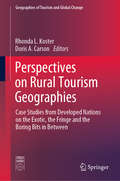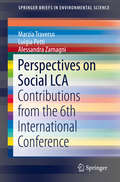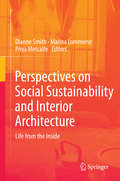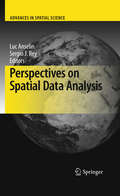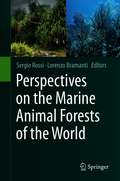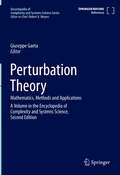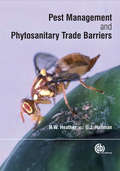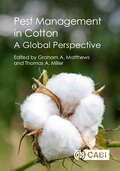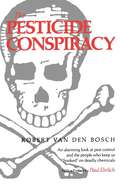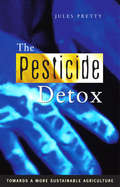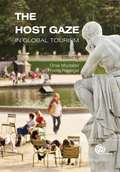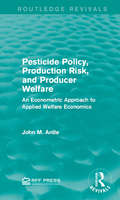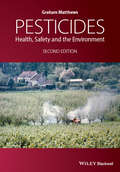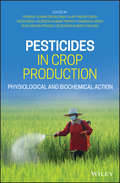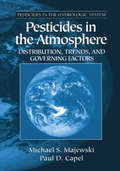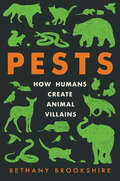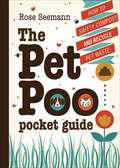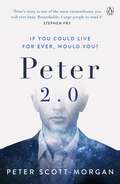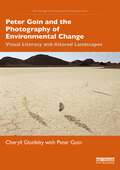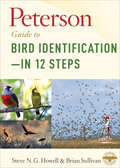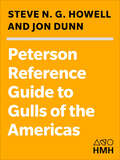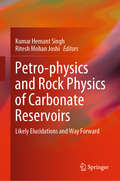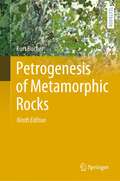- Table View
- List View
Perspectives on Rural Tourism Geographies: Case Studies from Developed Nations on the Exotic, the Fringe and the Boring Bits in Between (Geographies of Tourism and Global Change)
by Rhonda L. Koster Doris A. CarsonThis book examines rural tourism across three different contexts, acknowledging the complexity of rural places. It applies a systematic comparative framework across nine case studies from Australia, Canada and Sweden. The case studies address the uniqueness of different rural spaces, while the framework incorporates many theoretical aspects from human geography including spatial, historic, institutional, demographic, socio-economic and network perspectives. In the course of applying this comparative case study framework, the book identifies numerous implications for planning and policy in rural settings. These contributions from international, expert authors help to identify the opportunities and challenges that affect rural regions, from places at the urban fringe to exotic remote spaces and taking in the ‘boring bits in between.’ Both the analysis and the framework used will be of value to scholars and students of rurality, tourism, regional development, rural policy, geography, and destination management. Readers will gain a deeper understanding of the rural context in developed countries and a robust conceptualization of rural tourism geographies.
Perspectives on Social LCA: Contributions from the 6th International Conference (SpringerBriefs in Environmental Science)
by Marzia Traverso Luigia Petti Alessandra ZamagniThis book gives a selection of contributions from the 6th Social Life Cycle Assessment (S-LCA) Conference in Pescara, Italy. S-LCA is a social (real and potential) impact assessment method that aims to drive improvements in order to increase the value of products and services. It helps organizations to plan better, implement more effectively, and promote scale initiatives. More in general, the assessment activity also facilitates accountability and supports stakeholder communication. Consumers are greatly aware of the provenance of the goods they purchase. They have greater access to product information than ever before, also thanks to the new digital platforms. They are also empowered to make more responsible purchase decisions about what concerns sustainability aspects. Therefore the need to linger on the social aspects has been emerging recently. Although the business evolution of environmental methods and metrics has advanced significantly over the past decades, tools and metrics to estimate the social aspects of products and services are in progress. In this volume several sections provide methodological developments and tool focus, contextualizing S-LCA scientifically and explore the fields of applications. Through current development (conferences, articles, seminars and industry group publications), the method is spreading, evolving and gaining in maturity. However, it still is an evolving field, and main developments foresee, both at the level of methodology and results, interpretation and communication in order to find a path forward. S-LCA has been changing since the beginnings. From our observations as educators, researchers, practitioners, and peer reviewers in the S-LCA community, there are trends that are of importance us.
Perspectives on Social Sustainability and Interior Architecture
by Dianne Smith Marina Lommerse Priya MetcalfeThis book argues that interior architects have a responsibility to practice their profession in collaborative ways that address the needs of communities and of to be the agents of social justice and cultural heritage. The book is divided into three sections, based on three pivotal themes -- community engagement, social justice and cultural heritage. Each section has chapters that put forward the principles of these themes, leading into a variety of fascinating case studies that illustrate how socially sustainable design is implemented in diverse communities across the world. The second section includes four concise case studies of community housing issues, including remote-area indigenous housing and housing for the homeless. The third section offers two extensively researched essays on design and cultural heritage -- a case study of the development of a redundant industrial site and a historical study of gendered domestic interiors. The book appeals to a wider audience than the design community alone and challenges mainstream interior design/interior architecture practitioners nationally and internationally to take a leading role in the field of socially responsible design. The issues raised by the authors are relevant for individuals, communities, government and non-government organisations, professionals and students. "In the twenty-first century we seem to have entered into a new world of knowledge discovery, where many of the most exciting insights come not from the authority of a traditional discipline, but from the dialogue that happens at the hubs and intersections of thought -- the arenas where different disciplines and approaches, different schools and habits of thinking, come together to collaborate and contend. This collection is a good example of this, and I hope the book will be widely read and its lessons learned and applied. " Tim Costello, Officer of the Order of Australia, Chief Executive, World Vision Australia.
Perspectives on Spatial Data Analysis
by Luc Anselin Sergio J. ReyThis book takes both a retrospective and prospective view of the field of spatial analysis by combining selected reprints of classic articles by Arthur Getis with current observations by leading experts in the field. Four main aspects are highlighted, dealing with spatial analysis, pattern analysis, local statistics as well as illustrative empirical applications. Researchers and students will gain an appreciation of Getis' methodological contributions to spatial analysis and the broad impact of the methods he has helped pioneer on an impressively broad array of disciplines including spatial epidemiology, demography, economics, and ecology. The volume is a compilation of high impact original contributions, as evidenced by citations, and the latest thinking on the field by leading scholars. This makes the book ideal for advanced seminars and courses in spatial analysis as well as a key resource for researchers seeking a comprehensive overview of recent advances and future directions in the field.
Perspectives on Spin Glasses
by Pierluigi Contucci Cristian GiardinàPresenting and developing the theory of spin glasses as a prototype for complex systems, this book is a rigorous and up-to-date introduction to their properties. The book combines a mathematical description with a physical insight of spin glass models. Topics covered include the physical origins of those models and their treatment with replica theory; mathematical properties like correlation inequalities and their use in the thermodynamic limit theory; main exact solutions of the mean field models and their probabilistic structures; and the theory of the structural properties of the spin glass phase such as stochastic stability and the overlap identities. Finally, a detailed account is given of the recent numerical simulation results and properties, including overlap equivalence, ultrametricity and decay of correlations. The book is ideal for mathematical physicists and probabilists working in disordered systems.
Perspectives on the Marine Animal Forests of the World
by Sergio Rossi Lorenzo BramantiMarine Animal Forests (MAFs) are spread all over the world. Composed by suspension feeding organisms (e.g. corals, gorgonians, sponges, bryozoans, bivalves, etc.), MAFs constitute a vast number of marine ecosystems such as coral reefs, cold water corals, sponge grounds, bivalve beds, etc. The surface covered by these systems is prominent (at the scale of the oceans of the planet), though poorly known. In a previous book (Marine Animal Forests, the ecology of benthic biodiversity hotspots), several aspects of the MAFs were described and discussed, building the basis for a holistic approach with the aim of putting these shallow and deep sea ecosystems under a common umbrella. The main target of the present book is to identify and address important topics which were not covered in the previous three volumes. Bryozoans or Polychaeta, for example, are treated in this volume, as well as hydrothermal vents ecosystems and submarine caves, the chemical ecology in MAFs or the nursery effect on these ecosystems. The vastity of the MAF concept opens new insights in the biology, physiology, biodiversity of the organisms structuring these highly biodiverse ecosystems and on the dangers threatening them (such as microplastics or the role of invasive species as an impact of their trophic ecology or distribution). In a fast changing world, in which the complexity of MAFs is at risk, we propose an in-depth analysis of many aspects that may be inspirational for future research lines in marine biology and ecology.
Perturbation Theory: Mathematics, Methods and Applications (Encyclopedia of Complexity and Systems Science Series)
by Giuseppe GaetaThis volume in the Encyclopedia of Complexity and Systems Science, Second Edition, is devoted to the fundamentals of Perturbation Theory (PT) as well as key applications areas such as Classical and Quantum Mechanics, Celestial Mechanics, and Molecular Dynamics. Less traditional fields of application, such as Biological Evolution, are also discussed. Leading scientists in each area of the field provide a comprehensive picture of the landscape and the state of the art, with the specific goal of combining mathematical rigor, explicit computational methods, and relevance to concrete applications. New to this edition are chapters on Water Waves, Rogue Waves, Multiple Scales methods, legged locomotion, Condensed Matter among others, while all other contributions have been revised and updated. Coverage includes the theory of (Poincare’-Birkhoff) Normal Forms, aspects of PT in specific mathematical settings (Hamiltonian, KAM theory, Nekhoroshev theory, and symmetric systems), technical problems arising in PT with solutions, convergence of series expansions, diagrammatic methods, parametric resonance, systems with nilpotent real part, PT for non-smooth systems, and on PT for PDEs [write out this acronym partial differential equations]. Another group of papers is focused specifically on applications to Celestial Mechanics, Quantum Mechanics and the related semiclassical PT, Quantum Bifurcations, Molecular Dynamics, the so-called choreographies in the N-body problem, as well as Evolutionary Theory. Overall, this unique volume serves to demonstrate the wide utility of PT, while creating a foundation for innovations from a new generation of graduate students and professionals in Physics, Mathematics, Mechanics, Engineering and the Biological Sciences.
Pest Management and Phytosanitary Trade Barriers
by Guy J. Hallman Neil W. HeatherA significant amount of the world's economy is based upon the international trade of agricultural produce. For the producing countries, a growing concern is the potential economic and ecological damage that invasive species could cause. While threats can be decreased through the regulation of items potentially carrying invasive species, the effect of such restrictions on international trade also needs to be considered. A balance must therefore be met that permits the transfer of produce while filtering out unwanted pests. Drawing on the author's extensive experience, the social and financial implications of phytosanitary trade barriers are reviewed. This book offers valuable and comprehensive coverage of pest related barriers and strategies for their implementation.
Pest Management in Cotton: A Global Perspective
by Zeeshan AhmedThis book presents a global overview of the background to, and the current state of, crop protection and pest management in cotton crops. Cotton is one of the most economically important crops in the world and has been grown for centuries but maintaining high yields of good quality requires sophisticated approaches to pest management. The introduction and use of pesticides over the decades significantly increased cotton yields but lead to many adverse environmental impacts. Over time, new and alternative insecticides were developed but overuse has enabled pests to develop significant resistance. The development of genetically modified cotton varieties with toxins derived from Bacillus thuringiensis enabled much improved control of lepidopteran larvae, including bollworms, but as the toxins had no effect on sucking pests, farmers had no choice but to continue using insecticides. Also, some of the new cotton varieties developed in recent times have not adapted to different climatic conditions and the quality of cotton fibre declined as a result. This book shows the need for more research to select cotton varieties with high quality fibres suitable for different cotton growing areas and to develop integrated pest management strategies to minimise the use of pesticides. It also demonstrates the need for an inter-disciplinary approach bringing together plant breeders, entomologists, plant pathologists, agronomists and agricultural engineers to achieve high yields of high quality cotton. In the future, farmers will need to adopt new technology to determine when and how pesticides are used in conjunction with cultural and biological control strategies. · Emphasises the importance of research on growing cotton in a world experiencing climate change · Demonstrates how crucial crop protection is in achieving high yields of high quality cotton · Shows how new technology will bring major changes in how cotton is grown in the future
The Pesticide Conspiracy
by Robert Van Den BoschProfessor van den Bosch of the University of California was one of the developers of Integrated Pest Management—the use of biological controls, improved pest knowledge and observation, and judicious application of chemicals only when absolutely necessary. His research often suggested that less or no pesticides should be applied, which made him the target of both open and clandestine attack from industry and government figures. In protest, he wrote this passionate account of what Ecology called "the ultimate social disaster of: evolving pesticide-resistant insects, the destruction of their natural predators and parasites, emergent populations of new insect pests, downstream water pollution, atmospheric pollution, the 'accidental' killing of wildlife and people, and the bankruptcies of indigenous and small farmers."As a new Introduction to this edition recounts, some lessening of dangerous overreliance on massive pesticide applications has been achieved since van den Bosch published this book in 1978—partly as a result of its influence. But the structural problems he described remain. The book has thus become a classic, along with Rachel Carson's Silent Spring.
The Pesticide Detox: Towards a More Sustainable Agriculture
by Jules PrettySince the 1960s, the world's population has more than doubled and agricultural production per person has increased by a third. Yet this growth in production has masked enormous hidden costs arising from widespread pesticide use - massive ecological damage and high incidences of farmer poisoning and chronic health effects. Whereas once the risks involved with pesticide use were judged to be outweighed by the potential benefits, increasingly the external costs of pesticides, to environments and human health, are being seen as unacceptable. In response to this trend, recent years have seen millions of farmers in communities around the world reduce their use of harmful pesticides and develop cheaper and safer alternatives. The Pesticide Detox explores the potential for the phasing-out of hazardous pesticides and the phasing-in of cost effective alternatives already available on the market. This book makes clear that it is time to start the pesticide detox and to move towards a more sustainable agriculture.
Pesticide Encyclopedia
by Vasant Gowariker V N Krishnamurthy Kalyani Paranjape Sudha GowarikerIn today's world, food security is an important issue. Food shortages push prices up, impacting upon the health and well-being of hundreds of millions of rural poor across the globe. One way to increase food security is to decrease the amount of yield lost to pests. The Pesticide Encyclopedia provides a comprehensive overview of the fight against pests, covering chemical pesticides, biocontrol agents and biopesticides. It also covers interrelated topics such as pesticide toxicity, legislation and regulation, handling, storage and safety aspects, IPM techniques, resistance management, interaction of pesticides with soil and the environment. An important reference for policy makers, advisers and students and researchers of crop science, this book also includes useful notes on commonly known plant diseases and pests.
Pesticide Policy, Production Risk, and Producer Welfare: An Econometric Approach to Applied Welfare Economics (Routledge Revivals)
by John M. AntleThe use of pesticides to control agricultural pests both benefits farm production and imposes health and environmental costs on producers and society. This title, first published in 1988, includes an application of the author’s methodology to tomato production, in which Antle illuminates the roles that alternative methods of pest management play in producer welfare. He also develops a more general empirical framework for studying producer welfare under uncertainty – a framework in which production risk, sequential decision making, and attitudes toward risk are integrated. This title will be of interest to students of environmental studies.
Pesticides
by Graham MatthewsCrop protection continues to be an important component of modern farming to maintain food production to feed an expanding human population, but considerable changes have occurred in the regulation of pesticides in Europe in the last decade. The aim has been to reduce their impact on people and the environment. This has resulted in a major reduction in the number of chemicals approved for application on crops. In other parts of the world, a continuing expansion in the growing of genetically modified crops has also changed the pattern of pesticide use. In this second edition, Graham Matthews, updates how pesticides are registered and applied and the techniques used to mitigate their effects in the environment. Information on operator safety, protection of workers in crops treated with pesticides and spray drift affecting those who live in farming areas is also discussed. By bringing together the most recent research on pesticides in a single volume, this book provides a vital up to date resource for agricultural scientists, agronomists, plant scientists, plant pathologists, entomologists, environmental scientists, public health personnel, toxicologists and others working in the agrochemical industry and governments. It should assist development of improvements in harmonising regulation of pesticides in countries with limited resources for registration of pesticides.
Pesticides in Crop Production: Physiological and Biochemical Action
by Prabhat Kumar SrivastavaA guide to the diversity of pesticides used in modern agricultural practices, and the relevant social and environmental issues Pesticides in Crop Production offers an important resource that explores pesticide action in plants; pesticide metabolism in soil microbes, plants and animals; bioaccumulation of pesticides and sensitiveness of microbiome towards pesticides. The authors explore pesticide risk assessment, the development of pesticide resistance in pests, microbial remediation of pesticide intoxicated legumes and pesticide toxicity amelioration in plants by plant hormones. The authors include information on eco-friendly pest management. They review the impact of pesticides on soil microorganism, crops and other plants along with the impact on other organisms like aquatic fauna and terrestrial animals including human beings. The book also contains an analysis of pesticide by GC-MS/MS (Gas Chromatography tandem Mass Spectrometry) a reliable method for the quantification and confirmation of multiclass pesticide residues. This important book: Offers a comprehensive guide to the use of the diversity of pesticides and the pertinent social and environmental issues Explores the impact of pesticides from morphological, anatomical, physiological and biochemical perspectives Shows how pesticides affects soil microorganisms, crops and other plants along with the impact on other organisms like aquatic fauna and animals Critically examines whether chemical pesticides are boon or bane and whether they can be replaced by environmental friendly pesticides Written for students, researchers and professionals in agriculture, botany, entomology and biotechnology, Pesticides in Crop Production examines the effects of chemical pesticides and the feasibility of using bio-pesticides.
Pesticides in the Atmosphere: Distribution, Trends, and Governing Factors
by Michael S. MajewskiMost people know about the presence and health effects of pesticide residues in the water they drink. However, they may not realize the impact of atmospheric transportation and deposition of pesticides on water quality. Scientific studies of pesticides in various atmospheric matrices (air, rain, snow, aerosols, and fog) provide some of the answers.
Pests: How Humans Create Animal Villains
by Bethany BrookshireAn engrossing and revealing study of why we deem certain animals “pests” and others not—from cats to rats, elephants to pigeons—and what this tells us about our own perceptions, beliefs, and actions, as well as our place in the natural worldA squirrel in the garden. A rat in the wall. A pigeon on the street. Humans have spent so much of our history drawing a hard line between human spaces and wild places. When animals pop up where we don’t expect or want them, we respond with fear, rage, or simple annoyance. It’s no longer an animal. It’s a pest.At the intersection of science, history, and narrative journalism, Pests is not a simple call to look closer at our urban ecosystem. It’s not a natural history of the animals we hate. Instead, this book is about us. It’s about what calling an animal a pest says about people, how we live, and what we want. It’s a story about human nature, and how we categorize the animals in our midst, including bears and coyotes, sparrows and snakes. Pet or pest? In many cases, it’s entirely a question of perspective.Bethany Brookshire’s deeply researched and entirely entertaining book will show readers what there is to venerate in vermin, and help them appreciate how these animals have clawed their way to success as we did everything we could to ensure their failure. In the process, we will learn how the pests that annoy us tell us far more about humanity than they do about the animals themselves.
The Pet Poo Pocket Guide: How to Safely Compost and Recycle Pet Waste
by Rose SeemannEighty-three million dogs and ninety-six million cats call the United States home. Dogs alone produce enough waste to fill more than 1,091 football fields 1 foot deep in a single year. Add billions of plastic pick-up bags to the mix and season well with tons of litter box waste. Scoop a hefty portion into local landfills and seal it tightly to ensure optimal methane production. Clearly, this is a recipe for disaster.Dog and cat owners who trash their pets' offerings daily are in denial about how much waste is produced and what happens to it. Those who want to make the responsible choice often turn to the internet, only to find misleading, confusing, and contradictory information. The Pet Poo Pocket Guide will help you reduce your pet's environmental paw print with: Best practices for cycling pet waste back to nature Suggestions on how to tailor your approach based on location, situation, weather, needs, or available time Instructions for using your composted pet waste safely to enrich your soil and nourish ornamental plantsWith recycling tactics clearly indicated as "easy," "moderate," or "demanding," The Pet Poo Pocket Guide offers something for everyone. This no-nonsense guide is a must-read for any pet owner who is concerned about the environmental impact of their best friend, and is seeking a safe and practical solution.Rose Seemann is the owner and operator of EnviroWagg, a company dedicated to collecting and composting canine waste into safe, nutrient-rich garden soil.
Peter 2.0: The Human Cyborg
by Peter Scott-MorganThe incredible book behind the primetime Channel 4 documentary, Peter: The Human Cyborg'A remarkable account of what it means to be human and what technology can really achieve' Sunday Telegraph'Peter's story is one of the most extraordinary you will ever hear. I urge people to read it' Stephen Fry'A remarkable story . . . you're left desperate to take nothing for granted' Radio Times __________ Peter, a brilliant scientist, is told that he will lose everything he loves. His husband. His family. His friends. His ability to travel the world. All will be gone. But Peter will not give up. He vows that this will not be the end and instead seeks a completely new beginning . . . Peter has Motor Neurone Disease, a condition universally considered by doctors to be terminal. He is told it will destroy his nerve cells and that within about two years, it will take his life too. But, face-to-face with death, he decides there is another way. Using his background in science and technology, he navigates a new path, one that will enable him not just to survive, but to thrive. This is the astonishing true story about Peter Scott-Morgan: the first person to combine his very humanity with artificial intelligence and robotics to become a full Cyborg. His discovery means that his terminal diagnosis is negotiable, something that will rewrite the future.And change the world. By embracing love, life and hope rather than fear, tragedy and despair, he will become Peter 2.0. __________'Compelling . . . Scott-Morgan is a true one-off. It is in the telling of the love story, rather than the technical details of becoming a cyborg, that this book succeeds' The Times 'What's striking is Peter's constant optimism, bravery and his ability to find radical answers to problems that have confounded Britain's brightest minds' Daily Telegraph 'A soaring love story' Financial Times 'Fascinating and extremely moving' Sun
Peter Goin and the Photography of Environmental Change: Visual Literacy and Altered Landscapes (Routledge Environmental Humanities)
by Peter Goin Cheryll GlotfeltyPeter Goin and the Photography of Environmental Change narrates the forty-year quest of award-winning and internationally exhibited contemporary photographer Peter Goin to document human-altered landscapes across America and beyond. It is a collaborative work between an artist and a literary critic, a retrospective of an accomplished environmental photographer, and an innovative education in visual reading. Enduring howling wind, pounding rain, and blistering sun, Goin bears witness to radioactive landscapes, abandoned mines, simulated swamps, rechanneled rivers, controlled burns, overgrown ruins, industrialized agriculture, shrinking reservoirs, feral spaces in the city, architected wilderness, sacred wastelands, contested borderlands, and more. Based on more than seventy hours of taped interviews with the artist spanning over a decade, trailblazing ecocritic Cheryll Glotfelty narrates the arc of Goin's career, sharing excerpts from their conversations that reveal his brilliant mind and piquant personality while situating his work within the broader context of environmental thinkers. This beautifully illustrated volume, with 200 images in color and black-and-white showcasing Goin’s work, will be a fascinating and insightful read for upper-level students, academics, and researchers in photography, environmental history and culture, landscape studies, and environmental humanities.
Peterson Guide To Bird Identification—in 12 Steps (The\crossover Ser.)
by N. G. Howell Brian L. Sullivan&“The birding equivalent of having Albert Einstein and Stephen Hawking teach you how to count, add, subtract, multiply, do long division, comprehend quantum mechanics, plus balance your checkbook. Bird watchers at every skill level will garner insights from this book.&” — Pete Dunne, author of Birds of Prey &“Identifying birds is a science and an art, involving far more than merely memorizing field marks. Steve Howell and Brian Sullivan are leading masters of this craft, and they share a wealth of inside knowledge in this gem of a book. If you're a birder at any level of experience, from beginner to expert, read this book from cover to cover and I guarantee it will improve your skills in the field.&” — Kenn Kaufman, author of the Kaufman Field Guide to Advanced Birding &“ . . . if you are going to have a book-based conversation with bird experts about identification, Howell and Sullivan are going to be at the top of the list. . . . [The Peterson Guide to Bird Identification—In 12 Steps] is a highly opinionated book reflecting the approach and thoughts of the authors. Which is exactly what makes it a book that all birders should read, consult, and maybe even, like me, read again.&” — Donna Schulman, 10,000 Birds.com &“This book is friendly, non-intimidating, and even humorous. New birders can acquire some basics from this handy little book, and experienced birders can pick up some vital pointers, especially useful when helping the uninitiated. . . . Basically, there is something in this short book for every birder, and the 152 pages present many opportunities for all birders to pick out and explore what that &‘something&’ may be.&” —Paul J. Baicich and Wayne Petersen, Birding Community E-bulletin —
Peterson Reference Guides To Gulls of The Americas (Peterson Reference Guides)
by N. G. Howell Jon DunnThis ambitious volume covers the 36 species of gulls that occur in North and South America, with detailed information to help you identify these fascinating but challenging birds in their many and varied plumages. With 1,160 carefully chosen color photographs, this new reference guide, written by two of North America's top gull experts, is the definitive new work on gulls of the Americas.Peterson Reference Guides offer authoritative, comprehensive information, including detailed text, maps, and superior illustrations. Written by expert authors, the guides are an unparalleled resource for understanding specific groups of animals.
Peterson's First Guide to Seashores
by John KricherPeterson First Guides are the first books the beginning naturalist needs. Simplified versions of the famous Peterson Field Guides, the First Guides focus on the animals, plants, and other things you are most likely to see. They make it easy to get started in the field-and easy to graduate to the full-fledged Peterson Guides.
Petro-physics and Rock Physics of Carbonate Reservoirs: Likely Elucidations and Way Forward
by Kumar Hemant Singh Ritesh Mohan JoshiThis book presents selected articles from the workshop on "Challenges in Petrophysical Evaluation and Rock Physics Modeling of Carbonate Reservoirs" held at IIT Bombay in November 2017. The articles included explore the challenges associated with using well-log data, core data analysis, and their integration in the qualitative and quantitative assessment of petrophysical and elastic properties in carbonate reservoirs. The book also discusses the recent trends and advances in the area of research and development of carbonate reservoir characterization, both in industry and academia. Further, it addresses the challenging concept of porosity portioning, which has huge implications for exploration and development success in these complex reservoirs, enabling readers to understand the varying orders of deposition and diagenesis and also to model the flow and elastic properties.
Petrogenesis of Metamorphic Rocks (Springer Textbooks in Earth Sciences, Geography and Environment)
by Kurt BucherThis new edition of the classic textbook presents a large number of diagrams showing the stability relations among minerals and groups of minerals found in metamorphic rocks. The diagrams help to determine the pressure and temperature conditions under which a given set of metamorphic rocks may have formed. Other parameters that control metamorphic mineral assemblages are also discussed and pitfalls resulting from simplifications and generalizations are highlighted. The book discusses the most common metamorphic rock types, their nomenclature, structure and graphical representation of their mineral assemblages. Part I defines basic principles of metamorphism, introduces metamorphic processes, geologic thermometry and barometry and defines metamorphic grade. Part II presents in a systematic way mineralogical changes and assemblages found in the most common types of metamorphic rocks. The computation of diagrams is based on recent advances in quantitative petrology and geochemistry. An extensive bibliography, including the key contributions and classic papers in the field, make it an invaluable source book for graduate students and professional geologists.
